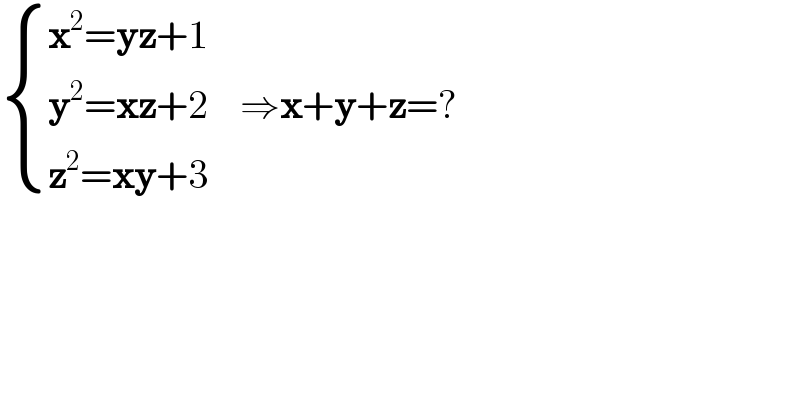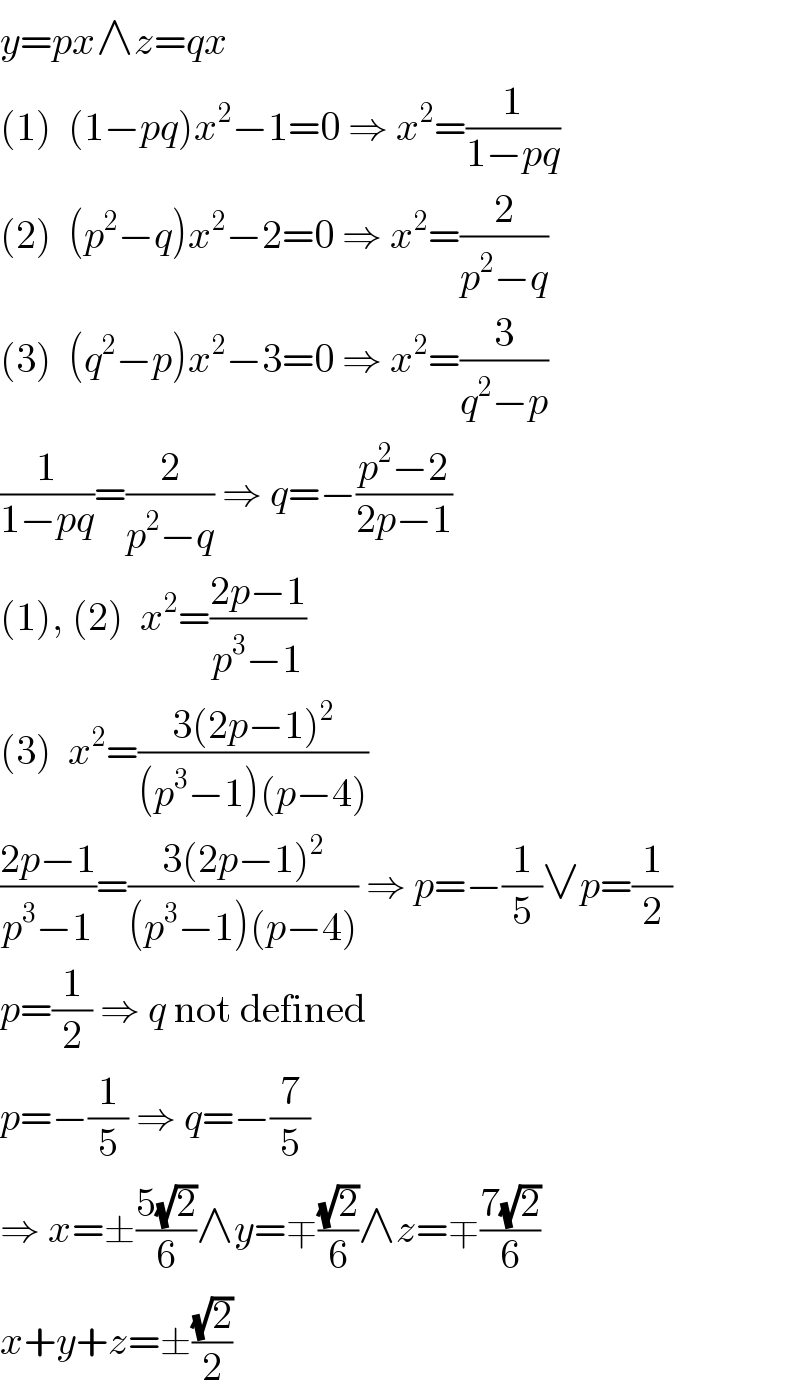
Question Number 74912 by behi83417@gmail.com last updated on 03/Dec/19

$$\begin{cases}{\boldsymbol{\mathrm{x}}^{\mathrm{2}} =\boldsymbol{\mathrm{yz}}+\mathrm{1}}\\{\boldsymbol{\mathrm{y}}^{\mathrm{2}} =\boldsymbol{\mathrm{xz}}+\mathrm{2}}\\{\boldsymbol{\mathrm{z}}^{\mathrm{2}} =\boldsymbol{\mathrm{xy}}+\mathrm{3}}\end{cases}\:\:\:\:\Rightarrow\boldsymbol{\mathrm{x}}+\boldsymbol{\mathrm{y}}+\boldsymbol{\mathrm{z}}=? \\ $$
Answered by MJS last updated on 03/Dec/19

$${y}={px}\wedge{z}={qx} \\ $$$$\left(\mathrm{1}\right)\:\:\left(\mathrm{1}−{pq}\right){x}^{\mathrm{2}} −\mathrm{1}=\mathrm{0}\:\Rightarrow\:{x}^{\mathrm{2}} =\frac{\mathrm{1}}{\mathrm{1}−{pq}} \\ $$$$\left(\mathrm{2}\right)\:\:\left({p}^{\mathrm{2}} −{q}\right){x}^{\mathrm{2}} −\mathrm{2}=\mathrm{0}\:\Rightarrow\:{x}^{\mathrm{2}} =\frac{\mathrm{2}}{{p}^{\mathrm{2}} −{q}} \\ $$$$\left(\mathrm{3}\right)\:\:\left({q}^{\mathrm{2}} −{p}\right){x}^{\mathrm{2}} −\mathrm{3}=\mathrm{0}\:\Rightarrow\:{x}^{\mathrm{2}} =\frac{\mathrm{3}}{{q}^{\mathrm{2}} −{p}} \\ $$$$\frac{\mathrm{1}}{\mathrm{1}−{pq}}=\frac{\mathrm{2}}{{p}^{\mathrm{2}} −{q}}\:\Rightarrow\:{q}=−\frac{{p}^{\mathrm{2}} −\mathrm{2}}{\mathrm{2}{p}−\mathrm{1}} \\ $$$$\left(\mathrm{1}\right),\:\left(\mathrm{2}\right)\:\:{x}^{\mathrm{2}} =\frac{\mathrm{2}{p}−\mathrm{1}}{{p}^{\mathrm{3}} −\mathrm{1}} \\ $$$$\left(\mathrm{3}\right)\:\:{x}^{\mathrm{2}} =\frac{\mathrm{3}\left(\mathrm{2}{p}−\mathrm{1}\right)^{\mathrm{2}} }{\left({p}^{\mathrm{3}} −\mathrm{1}\right)\left({p}−\mathrm{4}\right)} \\ $$$$\frac{\mathrm{2}{p}−\mathrm{1}}{{p}^{\mathrm{3}} −\mathrm{1}}=\frac{\mathrm{3}\left(\mathrm{2}{p}−\mathrm{1}\right)^{\mathrm{2}} }{\left({p}^{\mathrm{3}} −\mathrm{1}\right)\left({p}−\mathrm{4}\right)}\:\Rightarrow\:{p}=−\frac{\mathrm{1}}{\mathrm{5}}\vee{p}=\frac{\mathrm{1}}{\mathrm{2}} \\ $$$${p}=\frac{\mathrm{1}}{\mathrm{2}}\:\Rightarrow\:{q}\:\mathrm{not}\:\mathrm{defined} \\ $$$${p}=−\frac{\mathrm{1}}{\mathrm{5}}\:\Rightarrow\:{q}=−\frac{\mathrm{7}}{\mathrm{5}} \\ $$$$\Rightarrow\:{x}=\pm\frac{\mathrm{5}\sqrt{\mathrm{2}}}{\mathrm{6}}\wedge{y}=\mp\frac{\sqrt{\mathrm{2}}}{\mathrm{6}}\wedge{z}=\mp\frac{\mathrm{7}\sqrt{\mathrm{2}}}{\mathrm{6}} \\ $$$${x}+{y}+{z}=\pm\frac{\sqrt{\mathrm{2}}}{\mathrm{2}} \\ $$
Commented by behi83417@gmail.com last updated on 04/Dec/19

$$\mathrm{dear}\:\mathrm{proph}\::\:\mathrm{MJS}!\:\mathrm{it}\:\mathrm{is}\:\mathrm{great}.\mathrm{thank}\:\mathrm{you} \\ $$$$\mathrm{very}\:\mathrm{much}\:\mathrm{sir}. \\ $$
